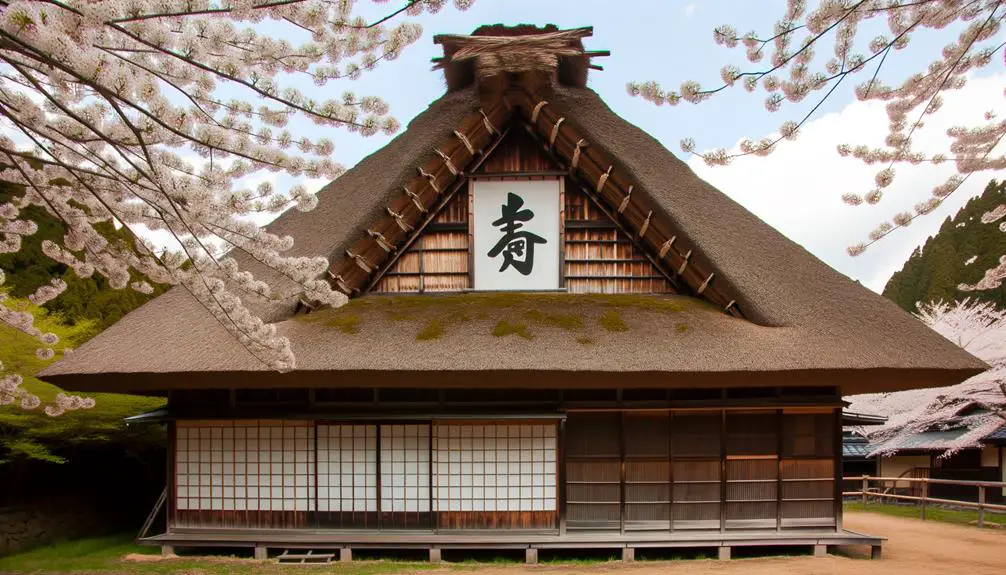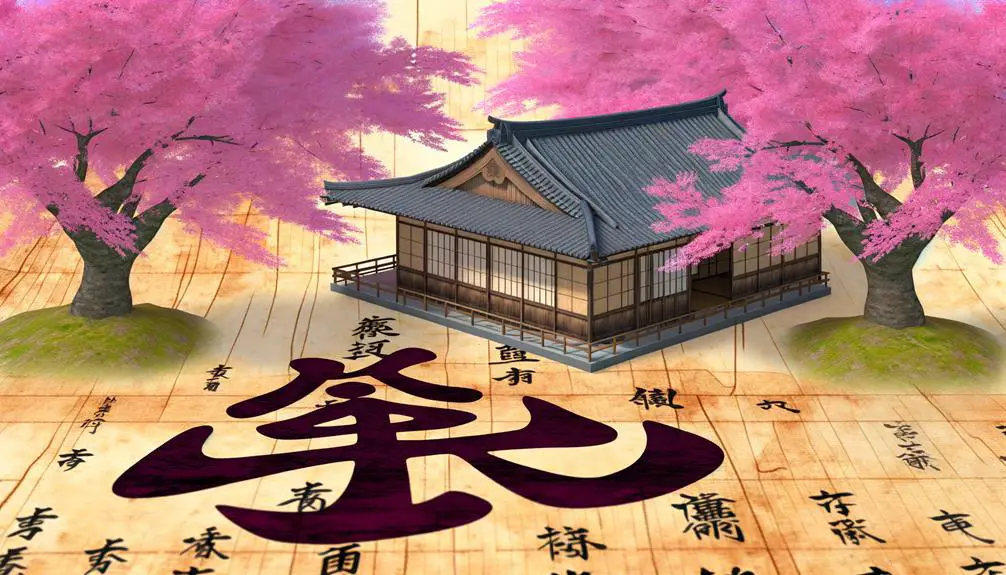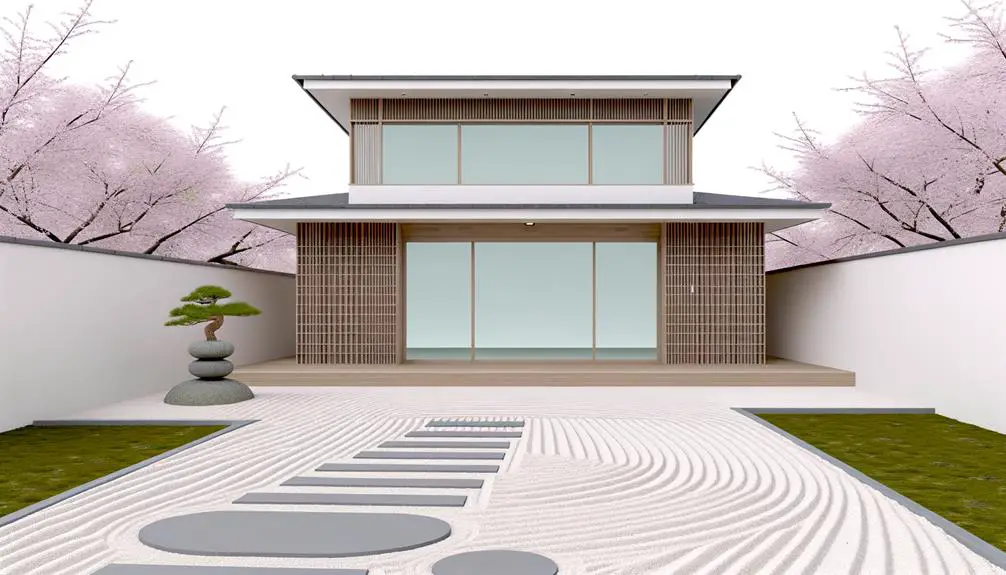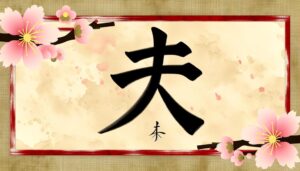What Japanese Symbol Looks Like a House?
The Japanese kanji '家' (ie/uchi), resembling a house, encapsulates profound cultural symbolism and historical evolution. Composed of the 'roof' radical and the character 'pig', it conveys self-sufficiency, stability, and familial bonds.
Introduced from China in the 5th century, it retains the essence of home, lineage, and community in Japanese culture. The symbol signifies not just a physical structure but also social identity and generational continuity.
It appears in words denoting household and family, reflecting traditional values and domestic life. By exploring further, one can gain a deeper understanding of this intricate symbol and its rich cultural context.

Key Takeaways
- The kanji 家 symbolizes a house or home in Japanese culture.
- Composed of the radical 宀 (roof) and the character 豕 (pig), indicating self-sufficiency.
- Represents family, home, lineage, and social identity in Japanese culture.
- Used in compound words like 'katei' (household) and 'kazoku' (family).
- Reflects traditional Japanese values like respect, harmony, and filial piety.
The Kanji: 家 (ie/uchi)

The kanji 家, pronounced 'ie' or 'uchi,' symbolizes a house or home and carries profound cultural and historical significance in Japanese society. This ideograph is composed of two parts: the radical 宀 (mian), meaning 'roof,' and the character 豕 (shi), representing a pig. Historically, the pig under the roof signifies a traditional household with its livestock, illustrating self-sufficiency.
Linguistically, 'ie' refers to the physical structure of a house, whereas 'uchi' emphasizes the concept of home and familial belonging. This duality reflects Japan's emphasis on both the tangible and intangible aspects of domestic life, highlighting the importance of family and social structure.
Ergo, 家 is more than a mere character; it encapsulates a pivotal aspect of Japanese cultural identity.
Historical Background
Understanding the historical background of the kanji 家 requires examining its evolution from ancient Chinese script to its adoption and adaptation within Japanese culture.
Originating from the Chinese character 'jia,' which depicted a dwelling with a pig under a roof, this symbol has been integral to both cultures for centuries.
In ancient China, the pig symbolized wealth and prosperity, making the character a meaningful representation of home.
When kanji were introduced to Japan during the 5th century, 家 retained its visual and semantic essence, denoting a house or family.
Over time, the character adapted to Japanese phonetics and social structures, reflecting the profound cultural and linguistic synthesis between China and Japan.
This historical journey underscores the rich heritage embedded in 家.
Cultural Significance

In Japanese culture, the kanji 家 (ie) encapsulates the profound concept of family, home, and lineage, reflecting its deep-rooted significance beyond mere architecture.
This character, denoting 'house,' carries with it connotations of familial bonds and generational continuity. Historically, it signifies not just a physical dwelling but also the locus of one's heritage and social identity.
The term 'ie' extends to the sociological construct of the household, embodying a collective unit that includes ancestors and descendants. In traditional contexts, the 'ie' system underscores patriarchal lineage and the perpetuation of family legacy.
Therefore, 家 (ie) serves as a cultural cornerstone, symbolizing stability, heritage, and the intricate web of relationships that define Japanese familial structures.
Symbolism of Home
The Japanese symbol that resembles a house encapsulates the profound cultural significance of home, reflecting traditional values such as familial bonds and communal harmony.
Historically, the concept of 'ie' (家) extends beyond the physical structure to embody the familial lineage and heritage.
Emotional connections are intrinsically linked to this symbol, manifesting a collective ethos that prioritizes unity and continuity.
Cultural Significance Explored
Delving into the cultural significance of the Japanese symbol that resembles a house reveals profound insights into the values and traditions surrounding the concept of home in Japanese society.
The symbol encapsulates a myriad of cultural dimensions, encompassing both tangible and intangible aspects:
- Family Unity: It signifies the importance of familial bonds and shared spaces.
- Safety and Stability: It represents a sanctuary offering physical and emotional security.
- Cultural Heritage: Traditional architectural elements evoke a deep connection to Japan's historical roots.
- Community: It reflects the integral role of neighborhoods and communal harmony.
This symbol not only embodies architectural aesthetics but also intertwines with the collective Japanese psyche, emphasizing the sacred and communal essence of the home.
Traditional Values Embedded
While exploring the symbolism of home in Japanese culture, one finds that traditional values such as respect, harmony, and filial piety are deeply embedded within the architectural and familial constructs. The Japanese home is not merely a physical structure but a manifestation of these values, evident in both design and daily life.
| Traditional Value | Manifestation in Home |
|---|---|
| Respect | Hierarchical seating |
| Harmony | Balance in architectural design |
| Filial Piety | Multi-generational living |
| Simplicity | Minimalist interior |
| Community | Open communal spaces |
Such values influence everything from the layout of rooms to the materials used, reflecting a deep cultural heritage that prioritizes social harmony and reverence for family.
Emotional Connections Highlighted
In Japanese culture, the concept of home extends beyond a physical space to encompass profound emotional connections that foster a sense of belonging and continuity. This symbolic representation of home underscores various elements that resonate deeply within the cultural psyche:
- Generational ties: Homes often serve as vessels of familial history, housing stories and memories passed down through generations.
- Community bonds: The house is a focal point for community interactions, reflecting the collective spirit and mutual support among neighbors.
- Safe haven: It represents a sanctuary, offering solace and security amidst life's uncertainties.
- Cultural preservation: Traditional homes embody architectural and cultural heritage, preserving practices and values integral to Japanese identity.
These emotional connections make the Japanese symbol for home a profound emblem of continuity and unity.
Usage in Language

The Japanese symbol that resembles a house, known as '家' (ie), plays an essential role in the language, signifying concepts related to home, family, and domestic life.
Historically, '家' encapsulates the traditional Japanese family structure, often extending beyond the nuclear family to include multiple generations under one roof.
Linguistically, it appears in various compound words, such as '家庭' (katei) meaning household, and '家族' (kazoku) meaning family.
Cultural practices, such as the ie system, underscore its significance, reflecting values of respect, duty, and continuity.
In literature and everyday language, '家' conveys more than a physical dwelling; it symbolizes identity, belonging, and the collective memory of familial heritage.
This multifaceted usage underscores its profound linguistic and cultural resonance.
Variations and Contexts
Beyond its primary meaning, the symbol '家' (ie) exhibits various forms and contexts that enrich its significance within Japanese language and culture. This kanji, representing 'house' or 'home,' extends its implications far beyond mere architecture. Historically, it signifies familial lineage and heritage, resonating deeply within societal structures.
- In surnames, such as 'Yamamoto-ie', it implies a familial house or clan.
- In compound words, like '家庭' (katei), it denotes concepts of household and family life.
- In traditional arts, phrases like '家元' (iemoto) indicate a head of a school or tradition.
- In idiomatic expressions, it can convey notions of origin and belonging, as seen in '家族' (kazoku), meaning family.
These variations underscore the kanji's multifaceted roles.
Modern Interpretations

Modern interpretations of the Japanese symbol resembling a house illustrate its profound influence on contemporary design and the evolving nature of cultural symbolism.
In present-day architecture and graphic design, this symbol is often reimagined to blend traditional aesthetics with innovative forms.
Additionally, its historical significance continues to adapt, reflecting the dynamic interplay between Japan's rich heritage and global cultural exchanges.
Contemporary Design Influence
In contemporary design, the Japanese symbol resembling a house serves as a pivotal element that bridges traditional aesthetics with modern architectural innovations. This emblematic character, often seen in kanji, embodies a synthesis of cultural heritage and cutting-edge design principles. Its influence is manifested in various facets of modern architecture and interior design, offering a harmonious blend of the old and the new.
- Minimalist structures that echo simplicity and functionality.
- Zen gardens integrating natural elements into living spaces.
- Tatami rooms that provide a serene, contemplative environment.
- Sliding shoji doors that enhance spatial fluidity and light diffusion.
These design elements reflect a deep respect for historical context while embracing contemporary needs, underscoring the timeless relevance of the Japanese house symbol.
Cultural Symbolism Evolution
The evolution of the Japanese house symbol in modern interpretations reflects a dynamic interplay between cultural heritage and contemporary societal values. Traditionally, this symbol, often represented by the kanji '家' (ie), encapsulates notions of family, stability, and ancestry. Today, its meaning has expanded to include innovative architectural aesthetics and sustainable living practices, mirroring Japan's adaptation to global environmental concerns.
Contemporary artists and designers frequently reinterpret this symbol to bridge the gap between time-honored traditions and modern minimalism. Additionally, in digital communication, the house symbol often serves as an emotive icon, representing comfort and a sense of belonging. Hence, the Japanese house symbol continues to evolve, harmonizing historical significance with present-day cultural and ecological consciousness.
Learning Tips and Resources
Exploring a variety of educational materials, such as textbooks, online courses, and mobile applications, can greatly enhance one's understanding of Japanese symbols, including those that resemble a house. A well-rounded approach to learning these symbols involves engaging with resources that provide cultural context, linguistic precision, and historical knowledge.
Consider the following tools:
- Textbooks and Language Guides: Offer structured learning and cultural insights.
- Online Courses: Provide interactive lessons often led by native speakers.
- Mobile Apps: Deliver convenient, on-the-go practice with visual aids.
- Cultural Workshops: Immerse learners in traditional and contemporary usage.
These resources collectively foster a deeper appreciation and comprehension of Japanese symbols, enriching the learning experience for those passionate about understanding this intricate language.
Conclusion
The kanji 家 (ie/uchi) encapsulates the essence of 'home' within Japanese culture, symbolizing not merely a physical structure but a nexus of familial and historical ties.
Much like a tree with deep roots, it represents stability, heritage, and connection.
Its multifaceted usage in language and evolving interpretations in modern contexts underscore its enduring significance.
Mastery of this kanji offers a window into the rich tapestry of Japanese cultural and linguistic traditions.






